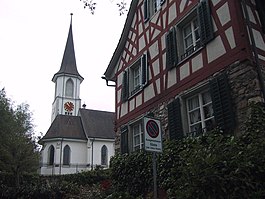Mammern
| Mammern | ||
|---|---|---|
 |
||
|
||
| Coordinates: 47°38′N 8°54′E / 47.633°N 8.900°ECoordinates: 47°38′N 8°54′E / 47.633°N 8.900°E | ||
| Country | Switzerland | |
| Canton | Thurgau | |
| District | Frauenfeld | |
| Area | ||
| • Total | 5.42 km2 (2.09 sq mi) | |
| Elevation | 400 m (1,300 ft) | |
| Population (Dec 2015) | ||
| • Total | 626 | |
| • Density | 120/km2 (300/sq mi) | |
| Postal code | 8265 | |
| SFOS number | 4826 | |
| Surrounded by | Eschenz, Herdern, Homburg, Hüttwilen, Öhningen (DE-BW), Steckborn | |
| Website |
www SFSO statistics |
|
Mammern is a municipality in Frauenfeld District in the canton of Thurgau, Switzerland, on Lake Constance.
Finds from the Neolithic Age, Bronze Age (including stilt houses and stone hatchets) and the Early Middle Ages show that there was a continuous settlement in the area. The modern village of Mammern is first mentioned in 909 as Manburron, when it was acquired by St. Gallen Abbey. They ruled over Mammern and Neuburg until the 12th Century. In 1319, St. Gallen pawned both villages to the Kastell family. Then, in 1522, Hans Leonhard von Reischach bought the villages. They were sold several times in the following century, until 1621 when Johann Friedrich Thumb gave the Herrschaft to the von Roll brothers who rebuilt the castle. In 1667 the Herrschaft was acquired by Wolf Rudolf Reding, who sold it in 1687 to Rheinau. Rheinau held the land rights to the village until 1798. From 1803 until 1992 the Ortsgemeinde of Mammern was part of the municipality of Steckborn.
At sometime before 1275 St. Gallen Abbey, built the village a church. The rights to collect church taxes and appoint priests remained with the Abbey until 1838 when those rights went to Canton of Thurgau. In 1843 that right went to the parish. The Protestant Reformation was introduced into the village in 1529. St. Gallen Abbey supported the Counter-Reformation through the investiture of Catholic judges. In 1749 the abbot of Rheinau Abbey, Bernhard Rusconi, built a baroque chapel near the castle. After the fire of 1909 destroyed the Simultankirche, in 1911 the Reformed church was dedicated followed by the Catholic Church in 1913.
...
Wikipedia



